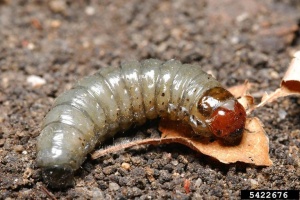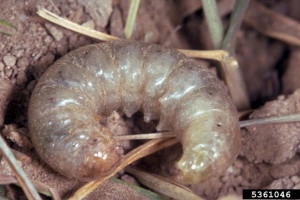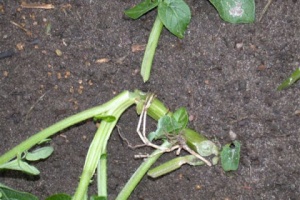Printable PDF
In This Issue
- Cutworms
- Springtails
- Green Peach Aphids
Cutworms
Monitoring
Cutworm larvae are active now (seen early as late January into April). They overwinter as the larvae stage in the soil or underneath plant debris. Various species found in Utah include the Army Cutworm (Euxoa auxiliaris), Black Cutworm (Agotis ipsilon), Glassy cutworm (Crymodes devastator), Pale Western Cutworm (Agrotis orthogonia), and Variegated Cutworms (Peridroma saucia). Monitor by looking for seedlings that have been cut off, then use a trowel to dig and search for larvae amongst the base soil. Cutworms are most active at night, so searching with a flashlight may help identify populations. Commercial growers should consider treatment when the threshold reaches five larvae per yd2.
Damage
Cutworms attack by using their chewing mouthparts to cut the seedlings near the soil surface. This can cause the young plants to fully be cut off. Some species may climb up on the foliage to chew holes or bore into heads of lettuce and cole crops. Damage can ultimately reduce plant stands.
Management
Cultural
- Remove cool-season garden weeds such as lambquarters and wild mustards that are growing near your field edges or garden. These weeds can serve as an alternate host. Sites with an early-season weed infestation are often more susceptible.
- Protect seedlings by using cardboard collars, screens, and protective cloths at the base of the plants. These barriers should be at least 2-3 inches tall and pushed firmly in the soil to prevent cutworms from crawling under.
Biological
- Wild birds often feed on cutworm larvae.
- Larvae may be parasitized by beneficial insects such as braconid wasps (Apanteles) and tachinid flies.
- Parasitic nematode (Steinernema carpocapsae)
Chemical
- BioAdvanced® Vegetable and Garden Insect Spray (cyfluthrin)
- Safer® Insecticidal Soap, Natria® Insecticidal Soap (insecticidal soap)
- Bonide® Thuricide®, Safer® Caterpillar Killer with Bt (Bacillus thuringiensis)
- Blackhawk®, Entrust®, Success® (spinosad)
- Radiant® (spinetoram)
- Brigade®, Capture® (bifenthrin)
- Azera® (pyrethrins + azadirachtin)
- XenTari®, Biobit® (Bacillus thuringiensis)
Springtails
Monitoring
Springtails are currently being seen feeding on brassica seedling. Springtails overwinter as “resting” adults right below the soil surface. They range from 1.5-3.2mm long, are grey, and have a unique tail-like structure (furcular) that hooks underneath their bodies. Monitoring when soils are wet (after rain) and there is lots of organic matter present.
Damage
Springtails can have specialized piercing-sucking mouthparts that allows them to cause damage to roots and first leaves of germinating seedlings. This ultimately leads to a loss in plant vigor and reduced stands.
Management
Chemical control is not recommended. Other control measures are rarely needed
Cultural
- Reduce moisture and excess organic matter.
- In greenhouses, wipe up pest colonies around the rims of the trays.
Green Peach Aphid
Monitoring
Green peach aphids (Myzus persicae) along with other aphid species are of concern starting now in mid-April through the rest of the season. Green Peach Aphids lay their eggs to overwinter on woody hosts such as peach, apricot, and plum trees. As the temperature warms they will migrate to various broadleaf weeds and vegetables, notably spinach, carrots, lettuce, and peas. Start scouting now through May. Identify clusters on the plant along with honey-dew excretion left by aphids.
Damage
Green peach aphids feed on host plants with their piercing-sucking mouthparts. They can attain high densities on younger plant tissues which may lead to water stress, wilting, and a reduced growth rate. Stippling, chlorosis, and leaf curling are other symptoms displayed by host plants. Green peach aphids are responsible for transmitting several viruses to vegetable crops.
Management
Cultural
- Avoid excess fertilization as aphids are attracted to high nitrogen levels.
- Start to remove weeds in and near the growing site.
Biological
- Encourage natural enemies (lady beetles, parasitic wasps, etc.). Typically appear as the temperature begins to warm.
Chemical
- Evergreen®, Pyganic®, Tersus® (pyrethrins)
- Azera® (pyrethrins+azadirachtin)
- Aza-Direct®, AzaGuard®, Azatin®, Molt (azadirachtin)
- Spectracide® Triazictide®
- GardenTech® Sevin
- Safer® Neem Oil (oils)
Note: All brands are registered trademarks. The brands listed in this table are not all-inclusive, but are meant to provide examples of products to control these pests in Utah. Always check the label for the specific crop you are treating, application and safety information, and protection and pre-harvest intervals.





























